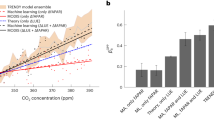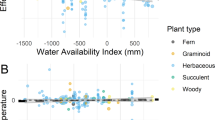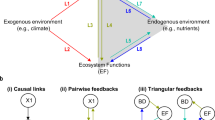Abstract
One feature of global change is that biota must respond not to single, but to multiple environmental drivers. By growing a model photosynthetic microbe in environments containing between one and eight different drivers, including changes in CO2, temperature, and pH, in different combinations, we show that the number as well as the identities of drivers explain shifts in population growth rates. This is because the biotic response to multiple environmental drivers depends on the response to the single dominant driver, and the chance of a driver of large effect being present increases with the number of drivers. Interactions between drivers slightly counteract the expected drop in growth. Our results demonstrate that population growth declines in a predictable way with the number of environmental drivers, and provide an empirically supported model for scaling up from studies on organismal responses to single drivers to predict responses to large numbers of environmental drivers.
This is a preview of subscription content, access via your institution
Access options
Subscribe to this journal
Receive 12 print issues and online access
$209.00 per year
only $17.42 per issue
Buy this article
- Purchase on Springer Link
- Instant access to full article PDF
Prices may be subject to local taxes which are calculated during checkout



Similar content being viewed by others
References
Boyd, P. W. & Hutchins, D. A. Understanding the responses of ocean biota to a complex matrix of cumulative anthropogenic change. Mar. Ecol. Prog. Ser. 470, 125–135 (2012).
Boyd, P. W., Lennartz, S. T., Glover, D. M. & Doney, S. C. Biological ramifications of climate-change-mediated oceanic multi-stressors. Nature Clim. Change 5, 71–79 (2015).
Folt, C. & Chen, C. Synergism and antagonism among multiple stressors. Limnol. Oceanogr. 44, 864–877 (1999).
Christensen, M. R. et al. Multiple anthropogenic stressors cause ecological surprises in boreal lakes. Glob. Change Biol. 12, 2316–2322 (2006).
Boyd, P. W. et al. Marine phytoplankton temperature versus growth responses from polar to tropical waters—outcome of a scientific community-wide study. PLoS ONE 8, e63091 (2013).
Boyd, P. & Brown, C. Modes of interactions between environmental drivers and marine biota. Front. Mar. Sci. 2, 9 (2015).
Gao, K., Ruan, Z. & Villafane, V. Ocean acidification exacerbates the effect of UV radiation on the calcifying phytoplankter Emiliania huxleyi. Limnol. Oceanogr. 54, 1855–1862 (2009).
Gao, K. et al. Rising CO2 and increased light exposure synergistically reduce marine primary productivity. Nature Clim. Change 2, 519–523 (2012).
Sciandra, A., Harlay, J. & Lefèvre, D. Response of coccolithophorid Emiliania huxleyi to elevated partial pressure of CO2 under nitrogen limitation. Mar. Ecol. Prog. Ser. 261, 111–122 (2003).
Lefebvre, S. C. et al. Nitrogen source and pCO2 synergistically affect carbon allocation, growth and morphology of the coccolithophore Emiliania huxleyi: Potential implications of ocean acidification for the carbon cycle. Glob. Change Biol. 18, 493–503 (2012).
Feng, Y. et al. Interactive effects of increased pCO2, temperature and irradiance on the marine coccolithophore Emiliania huxleyi (Prymnesiophyceae). Eur. J. Phycol. 43, 87–98 (2008).
Wu, Y., Gao, K. & Riebesell, U. CO2-induced seawater acidification affects physiological performance of the marine diatom Phaeodactylum tricornutum. Biogeosciences 7, 2915–2923 (2010).
Fischer, B. B., Rüfenacht, K., Dannenhauer, K., Wiesendanger, M. & Eggen, R. I. L. Multiple stressor effects of high light irradiance and photosynthetic herbicides on growth and survival of the green alga Chlamydomonas reinhardtii. Environ. Toxicol. Chem. 29, 2211–2219 (2010).
Eyre-Walker, A. & Keightley, P. D. The distribution of fitness effects of new mutations. Nature Rev. Genet. 8, 610–618 (2007).
Troedsson, C. et al. Effects of ocean acidification, temperature and nutrient regimes on the appendicularian Oikopleura dioica: A mesocosm study. Mar. Biol. 160, 2175–2187 (2012).
Beardall, J., Stojkovic, S. & Larsen, S. Living in a high CO2 world: Impacts of global climate change on marine phytoplankton. Plant Ecol. Divers. 2, 191–205 (2009).
Gruber, N. Warming up, turning sour, losing breath: Ocean biogeochemistry under global change. Phil. Trans. A 369, 1980–96 (2011).
Lagator, M., Vogwill, T., Mead, A., Colegrave, N. & Neve, P. Herbicide mixtures at high doses slow the evolution of resistance in experimentally evolving populations of Chlamydomonas reinhardtii. New Phytol. 198, 938–945 (2013).
Falk, S., Samuelsson, G. & Oquist, G. Temperature-dependent photoinhibition and recovery of photosynthesis in the green alga Chlamydomonas reinhardtii acclimated to 12 and 27 °C. Physiol. Planta 78, 173–180 (1990).
Van Dam, J. W., Negri, A. P., Mueller, J. F., Altenburger, R. & Uthicke, S. Additive pressures of elevated sea surface temperatures and herbicides on symbiont-bearing foraminifera. PLoS ONE 7, e33900 (2012).
Kobayashi, Y. et al. Algae sense exact temperatures: Small heat shock proteins are expressed at the survival threshold temperature in Cyanidioschyzon merolae and Chlamydomonas reinhardtii. Genome Biol. Evol. 6, 2731–2740 (2014).
Larras, F. et al. The effect of temperature and a herbicide mixture on freshwater periphytic algae. Ecotoxicol. Environ. Saf. 98, 162–170 (2013).
Sorokin, C. & Krauss, R. W. The Effects of light intensity on the growth rates of green algae. Plant Physiol. 33, 109–113 (1958).
Osborne, B. A. & Raven, J. A. Growth light level and photon absorption by cells of Chlamydomonas rheinhardtii, Dunaliella tertiolecta (Chlorophyceae, Volvocales), Scenedesmus obliquus (Chlorophyceae, Chlorococcales) and Euglena viridis (Euglenophyceae, Euglenales). Br. Phycol. J. 21, 303–313 (1986).
Gerloff-Elias, A., Spijkerman, E. & Pröschold, T. Effect of external pH on the growth, photosynthesis and photosynthetic electron transport of Chlamydomonas acidophila Negoro, isolated from an extremely acidic lake (pH 2.6). Plant Cell Environ. 28, 1218–1229 (2005).
Krause, G. & Weis, E. Chlorophyll fluorescence and photosynthesis: The basics. Annu. Rev. Physiol. Plant Mol. Biol 42, 313–349 (1991).
Riebesell, U. Effects of CO2 Enrichment on Marine Phytoplankton. J. Oceanogr. 60, 719–729 (2004).
Collins, S., Sültemeyer, D. & Bell, G. Changes in C uptake in populations of Chlamydomonas reinhardtii selected at high CO2 . Plant Cell Environ. 29, 1812–1819 (2006).
Engel, A. et al. Testing the direct effect of CO2 concentration on a bloom of the coccolithophorid Emiliania huxleyi in mesocosm experiments Marie-Dominique Pizay. Limnol. Oceanogr. 50, 493–507 (2005).
Merchant, S. S. et al. Between a rock and a hard place: Trace element nutrition in Chlamydomonas. Biochim. Biophys. Acta Mol. Cell Res. 1763, 578–594 (2006).
Bölling, C. & Fiehn, O. Metabolite profiling of Chlamydomonas reinhardti under nutrient deprivation. Plant Physiol. 139, 1995–2005 (2005).
Wykoff, D. D., Davies, J. P., Melis, A. & Grossman, A. R. The regulation of photosynthetic electron transport during nutrient deprivation in Chlamydomonas reinhardtii. Plant Physiol. 117, 129–139 (1998).
Smith, R. C. et al. Ozone depletion: Ultraviolet radiation and phytoplankton biology in Antarctic waters. Science 255, 952–959 (1992).
Sinha, R. P. & Hader, D. P. Life under solar UV radiation in aquatic organisms. Adv. Space Res. 30, 1547–1556 (2002).
Irihimovitch, V. & Yehudai-Resheff, S. Phosphate and sulfur limitation responses in the chloroplast of Chlamydomonas reinhardtii. FEMS Microbiol. Lett. 283, 1–8 (2008).
Hartmann, M. et al. Comparison of phosphate uptake rates by the smallest plastidic and aplastidic protists in the North Atlantic subtropical gyre. FEMS Microbiol. Ecol. 78, 327–335 (2011).
Lin, Y. J., Karuppiah, M., Shaw, A. & Gupta, G. Effect of simulated sunlight on atrazine and metolachlor toxicity of surface waters. Ecotoxicol. Environ. Saf. 43, 35–37 (1999).
Mayer, P., Frickmann, J., Christensen, E. R. & Nyholm, N. Influence of growth conditions on the results obtained in algal toxicity tests. Environ. Toxicol. Chem. 17, 1091–1098 (1998).
Harris, E. H. The Chlamydomonas Sourcebook: A Comprehensive Guide to Biology and Laboratory Use (Academic Press, 1989).
IPCC Climate Change 2013: The Physical Science Basis (eds Stocker, T. F. et al.) (Cambridge Univ. Press, 2013).
Collins, S. Many possible worlds: Expanding the ecological scenarios in experimental evolution. Evol. Biol. 38, 3–14 (2010).
Bell, G. Evolutionary rescue and the limits of adaptation. Phil. Trans. R. Soc. B 368, 1–6 (2013).
Leonardos, N. & Geider, R. J. Elevated atmospheric carbon dioxide increases organic carbon fixation by Emiliania Huxleyi (Haptophyta), under nutrient-limited high-light conditions1. J. Phycol. 41, 1196–1203 (2005).
Schippers, P., Lurling, M. & Scheffer, M. Increase of atmospheric CO2 promotes phytoplankton productivity. Ecol. Lett. 7, 446–451 (2004).
De Baar, H. J. W. Synthesis of iron fertilization experiments: From the Iron Age in the Age of Enlightenment. J. Geophys. Res. 110, C09S16 (2005).
Hein, M. & Sand-Jensen, K. CO2 increases oceanic primary production. Nature 388, 526–527 (1997).
Dupont, S. & Portner, H. Get ready for ocean acidification. Nature 498, 429 (2013).
Hutchins, D. A. et al. CO2 control of Trichodesmium N2 fixation, photosynthesis, growth rates, and elemental ratios: Implications for past, present, and future ocean biogeochemistry. Limnol. Oceanogr. 52, 1293–1304 (2007).
Bindoff, N. L. et al. in Climate Change 2007: The Physical Science Basis (eds Solomon, S. et al.) Ch. 10, 747–845 (Cambridge Univ. Press, 2007).
Meehl, G. A. et al. in Climate Change 2007: The Physical Science Basis (eds Solomon, S. et al.) Ch. 5, 386–432 (Cambridge Univ. Press, 2007).
Müller, P., Li, X. P. & Niyogi, K. K. Non-photochemical quenching. A response to excess light energy. Plant Physiol. 125, 1558–1566 (2001).
Fischer, B. B., Wiesendanger, M. & Eggen, R. I. L. Growth condition-dependent sensitivity, photodamage and stress response of Chlamydomonas reinhardtii exposed to high light conditions. Plant Cell Physiol. 47, 1135–1145 (2006).
Pröschold, T., Harris, E. H. & Coleman, A. W. Portrait of a species: Chlamydonomas reinhardtii. Genetics 170, 1601–1610 (2005).
Coleman, A. W. & Mai, J. C. Ribosomal DNA and ITS-2 sequence comparisons as a tool for predicting genetic relatedness. J. Mol. Evol. 45, 168–177 (1997).
Collins, S. & De Meaux, J. Adaptation to different rates of environmental change in Chlamydomonas. Evolution 63, 2952–2965 (2009).
R Core Team R A Language and Environment for Statistical Computing (2013); http://www.R-project.org
Acknowledgements
We thank N. Colegrave for discussion on experimental design and statistics, J. Hadfield for discussion on statistics, H. Kuehne for technical assistance, and M. Waterfall for assistance with flow cytometry. This work was supported by the European Research Council (ERC) (FP7 grant number 260266) and a Royal Society (UK) University Research Fellowship to S.C.
Author information
Authors and Affiliations
Contributions
G.B. and S.C. designed the experiment, G.B. performed experiments and S.C. supervised laboratory work. Both authors contributed to statistical analysis and writing the article.
Corresponding author
Ethics declarations
Competing interests
The authors declare no competing financial interests.
Supplementary information
Rights and permissions
About this article
Cite this article
Brennan, G., Collins, S. Growth responses of a green alga to multiple environmental drivers. Nature Clim Change 5, 892–897 (2015). https://doi.org/10.1038/nclimate2682
Received:
Accepted:
Published:
Issue Date:
DOI: https://doi.org/10.1038/nclimate2682
This article is cited by
-
Single-cell adaptations shape evolutionary transitions to multicellularity in green algae
Nature Ecology & Evolution (2023)
-
Enhancement of diatom growth and phytoplankton productivity with reduced O2 availability is moderated by rising CO2
Communications Biology (2022)
-
Integrating Transcriptomics and Metabolomics to Characterize Metabolic Regulation to Elevated CO2 in Chlamydomonas Reinhardtii
Marine Biotechnology (2021)
-
Emerging contaminants affect the microbiome of water systems—strategies for their mitigation
npj Clean Water (2020)
-
Multiple interacting environmental drivers reduce the impact of solar UVR on primary productivity in Mediterranean lakes
Scientific Reports (2020)



